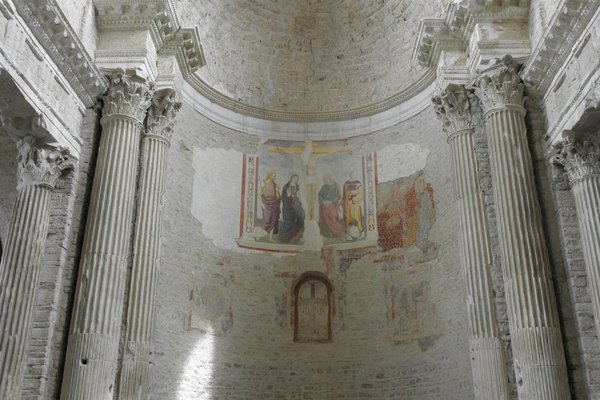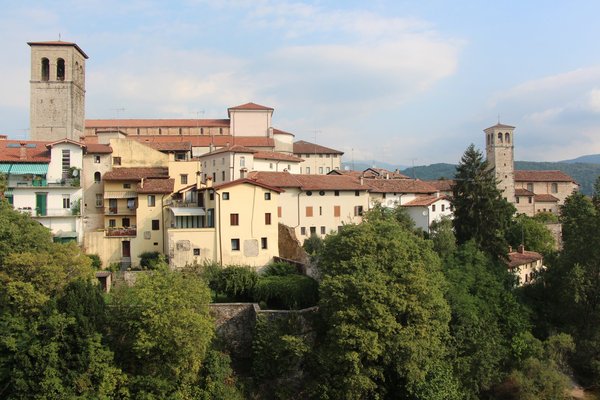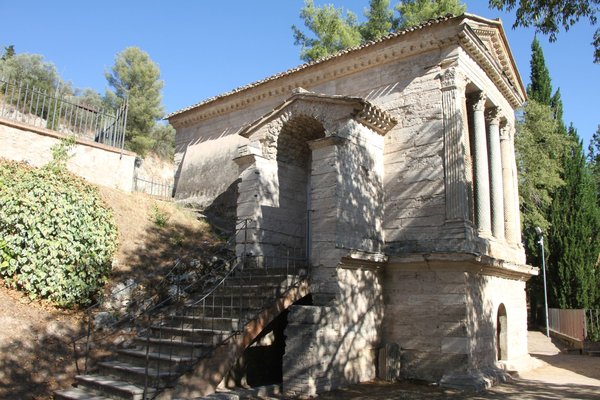Italy
Longobards in Italy
"Longobards in Italy. Places of the Power (568-774 A.D.)" marks the transition between Antiquity and the European Middle Ages.
This heritage was left behind by the Longobard / Lombard elite, a people of Germanic origin who converted to Christianity. They supported the monastic movement but also were instrumental in transferring literary, architectural and other works from Antiquity to the Middle Ages. Their built structures show stylistic diversity.
Community Perspective: The serial site comprises 7 groups of monuments spread across Italy, of which you’d need to visit a couple to get the idea. Reviewed are Monte Sant'Angelo (Klaus, Matejicek), San Salvatore-Santa Giulia in Brescia (the best place to start; John, Els, Nan), Cividale del Friuli (Ian, Tom, Claire), Tempietto del Clitunno and San Salvatore in Spoleto (Clyde, Els, Tom, Nan), Castelseprio-Torba (Els), and the Santa Sofia Complex in Benevento (Aspasia).
Site Info
Official Information
- Full Name
- Longobards in Italy. Places of the Power (568-774 A.D.) (ID: 1318)
- Country
- Italy
- Status
-
Inscribed 2011
Site history
History of Longobards in Italy
- 2011: Revision
- Includes the former TWHS Monte Sant'Angelo (2006), Santa Giulia-San Salvatore (1979), Santuario Rupestre of Olevano sul Tusciano, Castelseprio (1982) and part of Spoleto and Tempietto sul Clitunno (1996)
- 2011: Inscribed
- Inscribed
- 1981: Deferred
- As former TWHS Convent of Santa Giulia-San Salvatore: To be discused next year now Italy has submitted a T List
- 1980: Deferred
- As former TWHS Convent of Santa Giulia-San Salvatore
- 1979: Deferred
- As former TWHS Convent of Santa Giulia-San Salvatore: Concern that property not presented in the general context of cultural heritage of country as a whole. Italy to indicate properties it was to nominate
- Type
- Cultural
- Criteria
- ii
- iii
- vi
Links
- UNESCO
- whc.unesco.org
- Official
-
- longobardinitalia.it — I Longobardi in Italia
- italialangobardorum.it — Italia Langobardorum
- Related
-
- bresciamusei.com — Museo di Santa Giulia, Brescia
- castelseprio.net — Benvenuti a Castelseprio
All Links
UNESCO.org
- whc.unesco.org — whc.unesco.org/
Official Website
- longobardinitalia.it — I Longobardi in Italia
- italialangobardorum.it — Italia Langobardorum
Related Resources
- bresciamusei.com — Museo di Santa Giulia, Brescia
- castelseprio.net — Benvenuti a Castelseprio
Community Information
- Community Category
- Urban landscape: Medieval European
Travel Information
Exact locations inscribed twice (or more)
The Santa Sofia complex in Benevento is also part of the Via Appia.
Undergoing Restoration or Repair
Rome hotspot
Campania hotspot
See en.wikipedia.org
Lombardy hotspot
Trieste hotspot
See en.wikipedia.org
Apulia hotspot
Recent Connections
-
Exact locations inscribed twice (or more)
The Santa Sofia complex in Benevento is…
-
Griffins
"The small arches' decorations [of the … -
Votive churches
Benevento: the church of S. Sophia was …
Connections of Longobards in Italy
- Individual People
-
-
Lord Byron
Tempietto del Clitunno: described by Byron in Childe Harold's Pilgrimage (nom file + ita wiki) -
Charlemagne
Brescia, San Salvatore: "The monastery is traditionally considered the place where Desiderata, wife of Charlemagne and daughter of the Lombard King Desiderius, spent her exile after the annulment of her marriage in 771."See en.wikipedia.org
-
Frederick II
Monte Sant'Angelo: "The Castello was enlarged by the Normans (...), further modified by Frederick II. The massive, octagonal campanile was built in the late 13th century by Frederick II as a watchtower."See en.wikipedia.org
-
- Trivia
-
-
Modelled after
Torre Angioina of the San Michele Sanctuary is modelled after the towers of Castel del Monte. + Santa Safia, Benevento: "The church is on a central plan, with a diameter of 23.5 metres (77 ft), inspired by that of Hagia Sophia."See en.wikipedia.org
-
- History
-
-
Located in a Former Capital
Benevento was the capital of the Duchy of Benevento, and after 774, of the Principality of Benevento.See en.wikipedia.org
-
Carolingian Empire
Castelseprio-Torba: "It is well-known that Castelseprio was part of the orbit of the Royal court, as attested by its central role at a local level both during the Longobard and during the Carolingian period, when it was able to maintain this role as the centre of a County partly based on the structure of the giudicarìa which it had supplanted." (Nomination file, p. 153) – Cividale: "The area of the Longobard royal court (...) maintained its role as an administrative centre for fiscal issues also in the years following the Carolingian conquest, for a period which certainly included the whole of the 9th century. (Nomination file, p. 228) -
Fusion
"The Lombard monuments are an exemplary testimony to the cultural and artistic synthesis that occurred in Italy in the 6th to the 8th centuries, between the Roman heritage, Christian spirituality, Byzantine influence and the values derived from the Germanic world." (Official description – criterion ii) – "An immigrant people of Germanic origin, the Lombards settled in Italy and adopted Christianity. In the presence of an imposing Roman heritage and in contact with Byzantine and Middle Eastern influences, they developed their own unique cultural, architectural and artistic synthesis." (AB Ev) -
Republic of Venice
"In 1420 Cividale was annexed to the Republic of Venice." -
Normans
Monte Sant'Angelo: "When Benevento (...) fell during the 11th century, the sanctuary of St. Michael the Archangel was taken care of first by the Normans (...) The Castello was enlarged by the Normans upon an episcopal residence of Orso, Bishop of Benevento".See en.wikipedia.org
-
Popes
Santa Sophia in Benevento: "In 1688, a devastating earthquake hit the Samnium region, the effects of which were certainly felt by the church which lost a section of its original dome as a result of the falling bell-tower. (...) Cardinal Vincenzo Maria Orsini (later Pope Benedict XII) opted for the radical transformation of the church's architectural facies, rendering it more in keeping with the tastes of the day." (Nomination file, p. 265) -
Byzantine Empire and Civilization
Castelseprio-Torba: "Archaeological evidence (...) indicates that the Longobards only occupied the castle around the first decades of the 7th century, a sign that this castle, compared to others such as the Sirmione Fortress, remained in Byzantine hands for a longer period of time." (Nomination file, p. 141)
-
- Architecture
-
-
Spolia
In basilica of San Salvatore and Clitunno Tempietto -
Romanesque
a specific sub-style sometimes called "First Romanesque" or "Lombard Romanesque" -
Palladio and Palladian style
The Archaeological museum pf Cividale is situated in the "Palazzo dei Provveditori Veneti". This was "designed by Andrea Palladio and built between 1565 and 1596" See - -
Baroque
Santa Sophia in Benevento: "the façade shows baroque influences, mirroring the configuration given to the whole building over the years following the 1668 earthquake, and features a joined gable with a slightly curved peak." (Nomination file, p. 204) + "In 1957 most of the original appearance was restored, basing on evidence from historical documentation, with the exception of the Baroque façade." (wiki)See en.wikipedia.org
-
Domes
The dome of the church of Santa Sophia in Benevento (Nomination file, p. 201) -
Octagons
Campanille of the Sanctuary of Monte Sant'Angelo is octagonal, Octagonal lantern at Oratory of Santa Maria in Solario (San Salvatore, Brescia) (wiki)See en.wikipedia.org
-
Pre-Romanesque
See it.wikipedia.org
-
Brick architecture
The brick walls of the Longobard monastery of San Salvatore in Brescia. "The walls are made of bricks, reflecting the masonry work of the ecclesiastical building nearby." (Nomination file, p. 133) + Castelseprio-Torba: the "imposing brick masonry" of "the so-called "casaforte"", which was probably the seat of civil power of the site. (Nomination file, p. 143) + Santa Sophia in Benevento: "The outside walls (...) were realized in bordered brickwork with two rows of bricks interspersed with a row of irregularly hewn tufa blocks". (Nomination file, p. 204) -
Cave Temples or Churches
Saint Michael's grotto at Monte Sant'Angelo: "The cave comprised two cavities separated by a rock partition: a smaller one (...), where the Archangel purportedly left his footprints and where, at a later date, an altar was erected, known as the altar of the "Footprints". The larger of the two caves (...) was home to the altar upon which Michael is said to have lain his cloak, and a pitcher holding miraculous water (...)." "At a later date, the rock partition dividing the two caverns was demolished, thus creating a single large space". (Nomination file, p. 212, 215)See en.wikipedia.org
-
Gothic
Cividale: The Cathedral of Santa Maria Assunta "was definitively destroyed by another seismic disaster, in 1448. In 1451 it was decided that a new church should be built (...) in the gothic style". (Nomination file, p. 234) -
Mosaic art
"The Oratory of Santa Maria in Valle, the so-called Tempietto Longobardo, is a square building with a single nave, covered by a cross-vault. (...) The ensemble is richly decorated with stucco reliefs, frescoes, and mosaics." (AB Ev) – "The sumptuous decorative scheme, including mosaics on the vaults, stucco figures and ornaments, and a series of frescoes painted in aulic style (...)" (Nomination file, p. 88) -
Renaissance
Brescia: "The church of Santa Giulia was built during the Renaissance period and constitutes the Western boundary to the sequence of religious buildings within the monastery." (Nomination file, p. 134)
-
- Damaged
-
-
Destroyed or damaged by Earthquake
Cividale: "(...) the Patriarch's Palace (...) was mostly destroyed by the earthquake of 1511" – The dome of the church of Santa Sophia in Benevento was rebuilt after the 1668 earthquake. The cloister attached to the church was "probably destroyed by the earthquake on 25th October 989". (Nomination file, p. 112, 201, 206)
-
- World Heritage Process
-
-
Inscribed at third attempt or more
As former TWHS Convent of Santa Giulia-San Salvatore (Deferred in 1979, 1980 and 1981) -
Extended from original TWHS
Originally only Cividale del Friuli -
Ten years or more to inscribe
32 years (as former TWHS Convent of Santa Giulia-San Salvatore) -
Derived from more than one TWHS
Includes the former TWHS Monte Sant'Angelo (2006), Santa Giulia-San Salvatore (1979), Santuario Rupestre of Olevano sul Tusciano, and part of Spoleto and Tempietto sul Clitunno (1996) -
Exact locations inscribed twice (or more)
The Santa Sofia complex in Benevento is also part of the Via Appia.
-
- Religion and Belief
-
-
Votive churches
Benevento: the church of S. Sophia was "[f]ounded by duke Arechi II immediately after his election (758) as a national temple and votive chapel for the longobard people". (Nomination file, p. 199) -
Christian Pilgrimage Sites
Monte Sant'Angelo: is a Lombard national sanctuary and the origin of a pilgrimage dedicated to Saint Michael (AB ev) -
The Magi
A fresco depicting the Adoration of the Magi in the Church of Santa Maria foris portas in Castelseprio (Nomination file, p. 154, 156) -
Griffins
"The small arches' decorations [of the tegurium in the Basilica of Santa Maria] are framed by bands of intricate motifs and vegetal volutes, and include peacocks, lions, lambs, fishes, griffons, and deer, sculpted with a fresh, realistic style. (Nomination file, p. 109) -
Horse Burials
The Longobards also had a practice to bury horses with their dead warriors. One example is on display at the Archaeological Museum of Cividale. -
Franciscan Order
Castelseprio-Torba: "The farmhouse of San Giovanni, a small building of the 14th century, was built over the remains of a Longobard building, of which few elements have been identified. This was initially built as a monastery of the order of the Umiliati, later housed Franciscan friars, and was decorated with beautiful frescoes in the 16th century." (Nomination file, p. 152) -
Augustinian Order
Santa Sophia in Benevento: "at the end of the sixteenth century the building was abandoned and passed into the hands of the Augustinian Canon Regulars of SS. Salvatore until its dissolution by Napoleon." (Nomination file, p. 265) -
Situated on the "Sword of Michael" ley line
Sanctuary of San Michele -
Religious Relics
Benevento - The church of S. Sophia: " The building was probably completed by May 760, when in the course of a most solemn ceremony, the relics of the twelve Holy martyr Brothers were moved to the apse from various cities around Italy. In 768 the temple, symbol of longobard spirituality, became the resting place for the relics of St. Mercurius and later for a further thirty-one martyr saints and confessors." (Nomination file, p. 199) -
Benedictines
Brescia: "In 753 A.C. Desiderius and his wife Ansa began building a Benedictine nuns' convent, called San Salvatore, and entrusting its direction to their daughter Anselperga, who thus became the nunnery's first Abbess." (Nomination file, p. 123) -
Nunneries
Torba – "Torba lost its military function and acquired a religious one, thanks to the settlement here in the 8th century of a group of Benedictine nuns who had the monastery built, adding to the original structures further buildings to accommodate the cells, the refectory and the oratory, as well as a portico of three arches to shelter travellers and pilgrims, and in the 11th century a new small church dedicated to the Virgin Mary" (Wiki) See -See en.wikipedia.org
-
- Human Activity
-
-
Historical Graffiti
Monte Sant'Angelo: In the "crypts A, B and C, a vast number of objects, fragments and frescoes were discovered, but most important were the wall writings and graffiti, dating back to the time when these places were in use." "Evidence for the presence of pilgrims visiting the sanctuary between the end of the sixth and the mid-ninth century is provided through roughly two hundred inscriptions, carvings and scratched sketches executed on the surfaces inside the cave." (Nomination file, p. 217, 220) -
Piracy
"Between the end of the ninth century and the early years of the tenth, the sanctuary of St. Michael came under repeated attacks by the Saracens, the most serious of which took place in 869. The sanctuary was so badly damaged, probably as a result of this raid, that emperor Ludovic II (825-875) provided (...) the financial means to restore it." (Nomination file, p. 269) -
Mints
Casteseprio: "At one point coins were minted there - a sign of its importance."See en.wikipedia.org
-
Petrosomatoglyphs
Santuario di San Michele Archangelo: Michael the Archangel footprint, and hand-prints and footprints of pilgrims in underground corridors of the sanctuary
-
- Constructions
-
-
Necropolises
Castelseprio: "In the area in front of the church and near the perimeter walls of the Church of Santa Maria foris portas stood a necropolis that was laid out over several periods." (Nomination file, p. 156) -
Clock Tower
The clock tower of the Cathedral of Santa Maria Assunta in Cividale -
Freestanding Bell Tower
Campanille of the Sanctuary of Monte Sant'AngeloSee en.wikipedia.org
-
Protective Shelters
Castelseprio-Torba: at the basilica parts of the original floor are under a protective shelter -
Theatres and Opera Houses
Roman theatre in Brescia -
Cemeteries
Castelseprio: "The Church of Santa Maria foris portas in Castelseprio, a private aristocratic building with annexed cemetery" (AB Ev) + "The religious complex of San Giovanni Evangelista, consisting of a basilica with a baptistery and a cemetery" (Nomination file, p. 148) -
Obelisk
Benevento: "In 88/89 AD (year eight of the reign of emperor Domitian) two obelisks carvedfrom red Aswan granite were set up, flanking the entrance of a newly constructedtemple to the Egyptian goddess Isis, in Benevento (ancient Beneventum), Italy.One complete obelisk (Obelisk A) currently stands in the Piazza Papiniano inBenevento while its fragmentary twin (Obelisk B) is in the collection ofBenevento’s Museo del Sannio (inv. 1916)"See www.academia.edu
-
Cisterns
Castelseprio-Torba: "Along the Southern side of the basilica of San Giovanni is a large rectangular cistern dating back to Late Roman times. This was probably built to collect and use water from the roof of the church (...)." (Nomination file, p. 150) -
Cryptoporticus
Monte Sant'Angelo: "At a later date, the rock partition dividing the two caverns was demolished, thus creating a single large space which was reached by means of a new monumental flight of steps (...). At the same time, the monumental flight of steps was linked by two spans, at the central body by a structure comprising five spans; an eighth span on the opposite side of the steps served as an entranceway into the structure which took the form of a 40-metre long arcade, a sort of cryptoporticus which also served the purpose of offering temporary shelter to pilgrims (hospitium)." (Nomination file, p. 215) -
Dynastic Burial Places
Brescia: "Following the example of his predecessors, he [King Desiderius] too pursued the hope of defining a stable and lasting rule, (...) turning San Salvatore into a dynastic tomb, and centering his family's political and financial power upon the monastery of Santa Giulia. This is documented (...) by the fact that the monastery's founder Queen Ansa, and possibly other members of the family were buried in the church." (Nomination file, p. 139) -
Loggia
At Oratory of Santa Maria in Solario (San Salvatore, Brescia) -
Hospitals
Brescia: "The Monastery had service structures for the pilgrims reception and the poor housing. Historical sources recall the Xenodochio, which hosted the pilgrims, and the so called Peresindo's Hospital." (Nomination file, p. 89)
-
- WHS on Other Lists
-
-
Cultural WHS set within an IUCN recognised protected area
The Sanctuary of Monte Sant'Angelo lies in Parco Nazionale del Gargano (IUCN category 2) -
Most beautiful villages
Monte Sant'Angelo is among I piú bei borghi d'Italia ('Italy's most beautiful hamlets'), Cividale is among the Bandiere arancioni ('orange flags') by the Touring Club Italiano. -
INTO Places Program
Castelseprio-Torba: Torba is managed by FAISee fondoambiente.it
-
- Timeline
-
-
Built in the 6th century
ruled from the end of 6th century, the remaining monuments originate mostly from the 7th and 8th centuries
-
- WHS Hotspots
-
-
Rome hotspot
Spoleto: 2h train -
Campania hotspot
Benevento (about 1.5 hour by bus from Naples)See en.wikipedia.org
-
Lombardy hotspot
Brescia -
Trieste hotspot
Cividale del Friuli (1h50 by train)See en.wikipedia.org
-
Apulia hotspot
Santuario di San Michele Arcangelo in Monte Sant'Angelo : 153km / 3h by train
-
- Science and Technology
-
-
Early Archaeology
The archaeological area in Brescia had had "[a]rchaeological campaigns carried out since 1823 to the present". (Nomination file, p. 136)
-
- Visiting conditions
-
-
Undergoing Restoration or Repair
The website of the town of Spoleto states "the Basilica of San Salvatore is currently not accessible. It is not possible to enter but it is still possible to admire the interior from the main door." No date is given when the Basilica should be visitable again.
-
- WHS Names
-
-
Epic Subtitles
Places of Power (568-774AD)
-
- Literature & Film
-
-
Literature
The Lombards "also played an important role in the transmission of literary, technical, architectural, scientific, historical and legal works from Antiquity to the nascent European world." (Official description – criterion vi) -
Poetic Quotations
Temple of Clitumnus: "the shrine became a favoured venue for travellers and artists, and was even described by Byron in his verses." (Nomination file, p. 259) – Byron in "Childe Harold's Pilgrimage" (Canto IV, 66, 67, 68): "But thou, Clitumnus! in thy sweetest wave / Of the most living crystal that was e'er / (...) / And on thy happy shore a temple still, / Of small and delicate proportion, keeps, / Upon a mild declivity of hill, / Its memory of thee; beneath it sweeps / Thy current's calmness; oft from out it leaps / The finny darter with the glittering scales, / Who dwells and revels in thy glassy deeps; / While, chance, some scattered water-lily sails / Down where the shallower wave still tells its bubbling tales."
-
News
No news.
Recent Visitors
Visitors of Longobards in Italy
- 4lex
- Adam Hancock
- Adrian
- Adrian Turtschi
- Afshin Iranpour
- AK
- alex
- Alexander Barabanov
- Alexander Lehmann
- alicemears
- Aljaz
- A. Mehmet Haksever
- Ammon Watkins
- Anna Wludarska
- Antonio J.
- Argo
- Aspasia
- Astraftis
- Atila Ege
- BaziFettehenne
- Bill Maurmann
- Bin
- Bodil Ankerly
- Brendan Carroll
- Can SARICA
- Carlos Sotelo
- Caspar
- Cezar Grozavu
- chenqtao
- Cheryl
- Christian Wagner
- christof
- Christoph
- Christravelblog
- Claire Bradshaw
- ClaraHH
- Clyde
- Coppi
- Cristina Erba
- Csaba Nováczky
- CugelVance
- Cyberczar
- CynthiaW
- Dagmara
- Damientournay
- Daniela Hohmann
- Daniel Chazad
- Dan Pettigrew
- David Berlanda
- DavidS
- Dimitar Krastev
- Dirk-pieter
- Dolemite92
- Dorejd
- Dr. Caligari
- Dwight Zehuan Xiao
- Echwel
- edstar500
- Elaine McArdle
- Elia Vettorato
- Els Slots
- Emili Xaus
- Erfe91
- Erik G
- Errol Neo
- Eva Kisgyorgy
- Evgenii
- fabi-ddorf
- Fam39
- Fan Yibo
- Farinelli
- Federico P.
- Femke Roos
- Filip Murlak
- Flexiear
- Fmaiolo@yahoo.com
- Frederik Dawson
- FS
- George Gdanski
- GeorgeIng61
- Gernot
- HaraldOest
- Harald T.
- Harry Mitsidis
- Hasco
- hdimoshi
- henrik_hannfors
- Hubert
- Hurrvinek
- Iain Jackson
- Ian Cade
- Ilya Burlak
- Ivan Rucek
- Jaakkotoivanen
- Jakob F.
- Jakubmarin
- James Bowyer
- Jana and Matt
- janem
- Janina Lehmann
- Jan-Willem
- Jarek Pokrzywnicki
- Jasam
- Jean Lecaillon
- Jeanne OGrady
- Jeffrey Chai
- Jens
- Jezza
- João Aender
- JobStopar
- Joel on the Road
- John Smaranda
- Jonas Hagung
- Jonas Kremer
- Jon Eshuijs
- Joyce van Soest
- Jurre
- Justin
- KarenBMoore
- Karito Vies
- Kbecq
- Ken DJ
- Klaus Freisinger
- Knut
- Krzysztof B
- Kurt Lauer
- kutasp
- La Concy
- Lara Adler
- LaVale
- lindaann
- Lisu Marian
- Little Lauren Travels
- Loic Pedras
- Luboang
- Lucas Del Puppo
- Lucio
- Luis Filipe Gaspar
- Lukemarshall
- Maciej Gil
- marcel staron
- Martinacurra88
- Martina Rúčková
- Matejicek
- Mathijs
- Matthewsharris
- MAURO PODDA PANI
- Max
- MaYumin
- MH
- MichaelH
- Mihai Dascalu
- Mikko
- Monica Tasciotti
- MoPython
- nan
- Nasebaer
- Nihal Ege
- nikolamus
- PabloNorte
- Paola Laura
- Patrik
- Paul Schofield
- Peltzi
- PeterH
- Peter Lööv
- Petteri
- Philipp Leu
- Philipp Peterer
- phillipmeng
- Pieter Dijkshoorn
- Pincze
- Pink Bunny
- Piotr Wasil
- Porcho
- Purrfect
- Rafał Kałczuga
- Ralf Regele
- Randi Thomsen
- Remigiusz
- Riccardo Quaranta
- Rick Ohm
- Roccobot
- Roger Ourset
- Roman Bruehwiler
- Roman Raab
- Sabrina Liebehentschel
- Samato
- Samy G
- Schnitzel
- serghei.belous
- Sergio Arjona
- Shandos Cleaver
- Shombob
- SirLoydd
- Slavi
- Solivagant
- Sorel Americo
- Stanislaw Warwas
- Stefan A. Michelfeit
- stephanvermeulen
- Svein Elias
- Szabolcs Mosonyi
- Szucs Tamas
- Tamara Ratz
- Taotao Chen
- Tarquinio_Superbo
- TheTravelingRanger
- Thomas Buechler
- Thomas van der Walt
- Thorben
- Tim Allen
- Tinamu
- Tom Flaten
- tommasorossotti
- Tonisan
- tony0001
- triath
- Truls Brekke
- Tsunami
- Valentina
- Vanessa Buechler
- Viaje al Patrimonio
- Walter
- Wieland
- WILLIAM RICH
- Wimmy
- Wojciech Fedoruk
- Xander Huang
- Xiong Wei
- Xiquinho Silva
- YaroMir
- Yevhen Ivanovych
- Yongcheng Liu
- Zach
- Zizmondka
- Zoë Sheng
- Zos M
Community Reviews
Show full reviews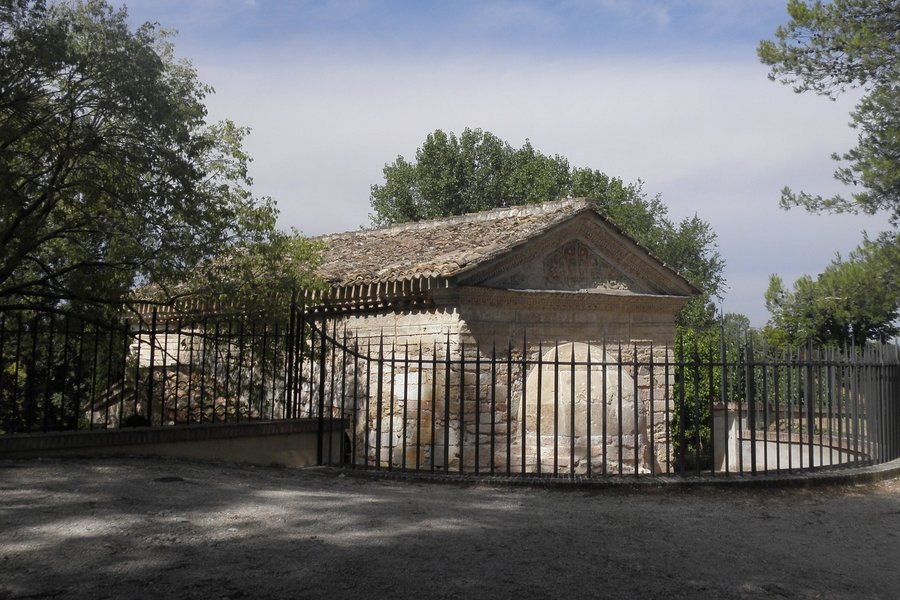
I was pleasantly surprised by how much I enjoyed the one Longobard site I visited so far (Castelseprio-Torba), partly due to apprehension from reading some of the previous reviews, but also because I don't think I could have chosen a day with worse weather. One benefit of going on one of the rainiest days in May that anyone I spoke to could remember is that I was the only visitor in the park.
Thankfully, much has seemingly improved since Els's visit with regard to signage and navigation, as I began to see signage for the archeological park for several kilometers. I drove, and Google Maps had the correct location and a parking lot available next to the info point. In addition to pamphlets and booklets explaining the site in multiple language, there were several staffers at the info office that were happy to provide assistance in multiple languages. Also, entrance is free.
This is where I come to what made my visit so much better than I expected. Not only did the staff direct me on where to visit, but two of the English speaking guides took me on a tour of the archeological park and to the small but well laid out museum (antiquarium) as well. I started with one of the guides taking me to the church of Santa Maria Foris Portas (despite signs indicating the church was closed at the time of my visit, my guide unlocked it for me) and explaining the history of …
Keep reading 0 comments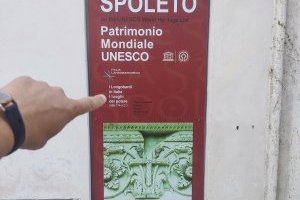
I visited two of the whs sites on oct the 4th. Early in the morning I took the train from Perugia( where I rented an apartment for one week in order to discover Umbria and its wonderful little gems) to Spoleto. This umbrian town turned out to be a true pearl.I immediately fall in love with that fascinating city. After visiting the duomo,the rocca albornaziano,and some sites in Spoleto and strolling through its medieval alleys I had to make a tough decision:Spoleto is a fantastic city which is really worth every minute you spend there and I would certainly recommend an overnight stay as night time surely adds its magic to that umbrian pearl...........earlier this year I had visited Sighisoara in Romania.....hands down Spoleto plays in a different dimension compared with that quite similar romanian counterpart.........I could either spend the enitre day till late evening in Spoleto with my wife or visit the temple of clitunno in nearby Pissignano(a stone's throw from Trevi and its train station).
After some hard thinking I decided to leave for Trevi(by train) and then took a bus to the nearest bus stop of that temple( I still had to walk around 10-15 min to reach the whs).
On the way to Spoleto's train station I first visited the city cemetary and its basilica di San Salvatore( whs site). The basilica is closed to the public.Nevertheless,the interior can be seen quite well through its glass cover which is right behind the open wooden …
Keep reading 0 comments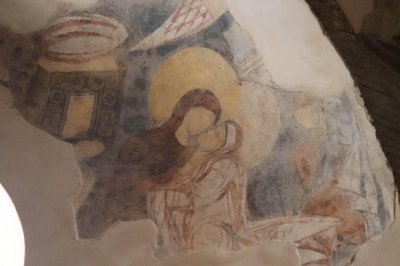
When I first saw the list of inscribed properties, I was surprised to see the south, since I was associating the longobards with the north of Italy (Lombardy). Only afterwards did I become aware that while Langobardia Maior was in the north, Langobardia Minor was centered in the centre and south (duchies of Spoleto and Benevento).
The property selected for Benevento is Santa Sofia Complex, built under Arechi II in the 8th century, which still holds paintings from 8-9 centuries. The monument did not disappoint, but then again, I am always impressed when I find art between the fall of the Roman Empire and the Carolingian Renaissance. The UNESCO plate is outside the church, on the right, as you enter the garden.
It is not the only monument from that period, it is worth taking a look at Sant’Ilario Church near the Arch of Trajan and the tower of Rocca dei Rettori. Moreover, this is the land of Samnites (see Livy, the Battle of Caudine Forks), as well the Italian version of Salem (it was only after my Airbnb host kept mentioning the ‘streghe’ and Isis that my brain started working).
It might be that I enjoyed this trip more because of the lack of tourists (I had the church all to myself), but Benevento was definitely worth a stop.
Keep reading 0 comments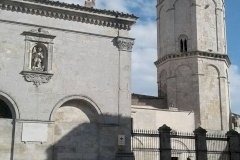
I would visit only three parts of this interesting WHS till now [Nos.1-2 already described by others, but No.3 not yet] but I want to explore most of the rest in the future.
(1) Relatively big church of S Salvadore in Spoleto with surprisingly preserved stucco on the main façade and re-used ancient columns, spolia, inside, (2) in contrast very small but nicely elaborated Tempietto in Clituno (till now my favorite component of this WHS), and…
(3) Santuario di San Michele Archangelo in Monte Sant`Angelo as one of the most important pilgrim sites in Europe.
I had big expectation towards the Sanctuary during my visit of the promontory of Gargano in autumn 2018, but it was rather disappoint. We explored the parts of Gargano by foot, and I really liked that, especially (i) the broad valley of Mattinata entirely covered by ancient olive groves, (ii) Foresta Umbra with its beech forests, (iii) my favorite Monte Sacro with the ruins of SS Trinita, and (iv) beautiful town of Vieste.
So, we did a day trip from our camp in the forest on the hill just opposite to the north from Monte S`Angelo. We descended to the deep of beautiful valley and climbed the steep slope with cows enjoying their poor pastures below the Sanctuary, which we approached from the backside. From this side, it looked like the treasury of a national bank with all the high fences and cameras above the austere asphalt road. So, my romantic …
Keep reading 0 comments
I visited the site at Cividale del Friuli today and must say I was a little disappointed. Maybe if I had visited additional sites included in this listing, I would have gained a deeper understanding into the inclusion of this town by UNESCO. The included area in the town is small, comprising only the cathedral and the area immediately surrounding it. The cathedral is nice, but nothing particularly special compared to others in northern Italy. The main highlight is the Longobard Temple in the Monastery set behind the cathedral. This is lovely but very small, and has a real sense of feeling special. The problem being that for me at least, I failed to grasp the reason for it being so special. The site didn't seem to have any detail on how this place fit into the wider listing.
Nevertheless the town itself is lovely, a series of winding, narrow and cobbled streets with a picturesque bridge over the river offering great views of the town and cathedral. I enjoyed my visit, but wished for more context. I will try to visit other sites in the listing in the future in the hope of broadening my understanding.
Note that the monastery, and thus the temple, is closed over lunchtime (12-2pm in winter, 12-3pm in summer). The entrance fee was EUR 4 per adult.
Keep reading 0 comments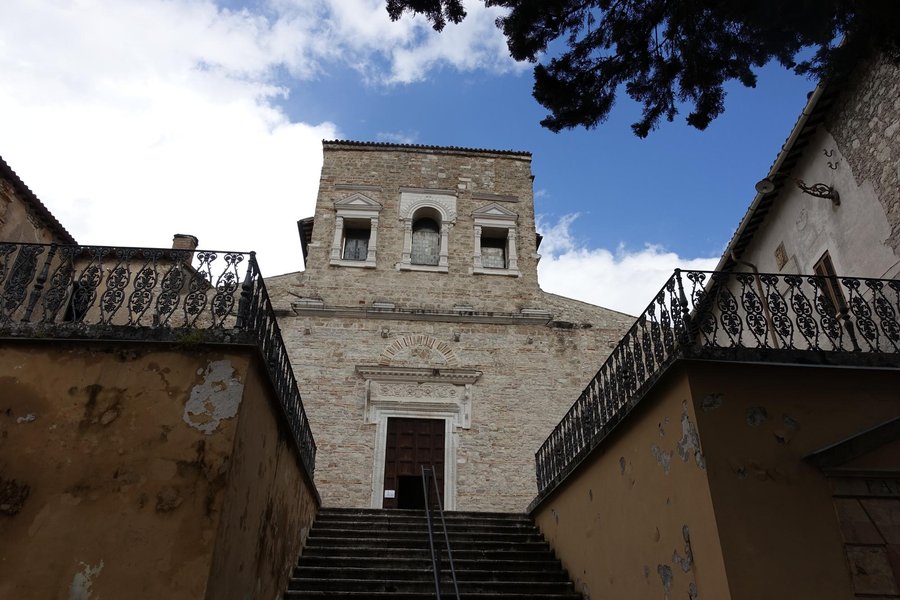
The transition from Antiquity to Medieval times can be well traced with world heritage sites. You start in Split where you get a last peek of Roman culture in Diocletian's Palace. Ravenna comes next and you already start noticing that a major culture shift has taken place. Everything is a lot smaller all the while less worldly and more religious. With the Longobards you complete the transition to the Medieval Age with small and mostly simple churches remaining.
As a short stop over on my way from Assisi to Rome I visited the Basilica San Salvatore in Spoleto. I was really lucky as the chapel is currently (April 2018) closed due to renovations. However for Easter they opened the door so you could take a look. There wasn't all that much to see, though, as it's a fairly plain chapel with simple painted decorations.
A few years before I had been to Santa Giulia museum in Brescia, originally built as a monastery by the Longobards. In comparison I found the site more interesting and accessible. A highlight is the oratory that was added in later centuries. Also, my understanding is that the nearby Roman ruins are also included in the inscribed site.
Getting There
Brescia is conviently located on the major North Italian railwail line running from Torino to Venezia offering easy access to all sites of the Milan and the Veneto hotspots. It's also from here that you can catch the train to Valcamonica.
Spoleto can be …
Keep reading 0 comments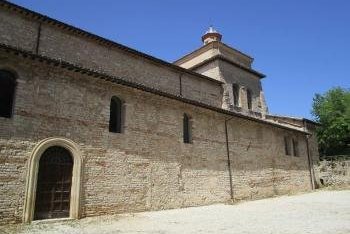
After visiting San Salvatore-Santa Giulia in Bresia in 2012, I never paid any more attention to Longobards in Italy.
In July 2017 I went to Spoleto to see two productions at the Spoleto Festival, perhaps the most important annual performing arts festival in Italy, and stayed there overnight.
I was pretty impressed with the town of Spoleto itself, complete with a Roman theater, a cathedral, a fortress and even an aqueduct behind the fortress that "almost" looks like Pont du Gard.
Walking from the lower tier to the upper tier of the old town, I was suddenly jolted by a sign that says "Spoleto the World Heritage City." "What??? How low can they (tourist office) go to call their city a World Heritage City when it's not?" was my first reaction, but the rest is history.
As it turns out, the Basilica of San Salvatore is in the core zone and the entire old town is in the buffer zone of this site, one of the 7 components of Longobards in Italy. But the Basilica is outside the old town center.
When I travel these days, I'm almost completely dependent on Google Map with the blue dot of my own location and with its search function. So locating the Basilica of San Salvatore was not a problem. But I noticed that while I saw many signs in the old town touting the Basilica as a WHS, once I tried to get there, I did not …
Keep reading 0 comments
Of the seven sites I have so far been to three: two in Umbria (visited April 2015), and one in Friuli-Venezia Guilia (July 2015).
The Clitunno Tempietto wasn’t easy to find, but I had been prepared for that and we soon located it. For a while we were the only people there, which was nice. I love it when I go to a World Heritage Site and there is nobody else around. You can see the Roman-style architecture of this temple – it looks nothing like a church, yet it was built for Christian worship in the Dark Ages.
Remnants from this period of history are not generally well-preserved; it is underrepresented on the UNESCO list, so you can really pick up something novel from visiting the Longobard sites.
The basilica of San Salvatore is just a short drive away, in the Umbrian town of Spoleto. It is a much larger building, and totally empty inside. I liked the basilica’s Byzantine depiction of Christ the Teacher.
The Gastaldaga area and the Episcopal complex in northeast Italy is in the charming town of Cividale del Friuli. We arrived there after seeing Škocjan Caves and Idrija mercury mine in Slovenia. The carved figures in the temple were inspired by the Porch of the Caryatids in the Erechtheion on Athens’ Acropolis.
Keep reading 0 comments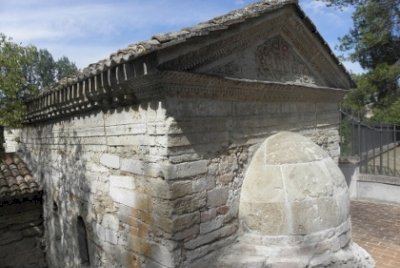
I visited the two inscribed sites in the former Longobard Duchy of Spoleto: the Clitunno Tempietto and the Basilica San Salvatore in Spoleto. They both were almost impossible to find. I relied on my car navigation to get me there, thinking that the sites would be posted from the main road also. But I had to search for quite a while: these are really minor sites, far off the beaten track.
I started at Clitunno, a small town in the mountains north of Spoleto. Some kind of market was going on, and both sides of the main street were littered with parked cars. The Tempietto is situated outside the center, actually along the main road but not visible from there. A tiny sign points to its location. Normally you can get there by car, but the road was blocked now due to the festivities. So I just walked there and had to ask once again for directions (as one sign really isn't enough). It turned out to be a cute little temple. Looked pre-Romanesque to my untrained eye, a bit similar to the Asturian monuments. The iron gates around it were closed, unfortunately: opening hours seem to be only in the afternoons. So I just took some pictures from behind the fence.
Then I went back to Spoleto, about 20 minutes away. Spoleto is a touristy city, with lots of history and an enormous castle as the main point of attraction. The San Salvatore Basilica isn't in the …
Keep reading 0 comments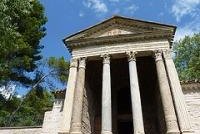
I visited this WHS in August 2013. Following Els' review, I did my research to have at least the name of the streets closest to the two sites near Spoleto. Still it was not easy to find them! Tempietto del Clitunno is just beside the motorway in Campello sul Clitunno, around 12km from Spoleto. The rear side of the temple is visible from the motorway. It is only open in the afternoon on certain weekdays and costs 2 euros to visit. It is kept in very good condition and I was happy to pay the entrance fee knowing that I was directly funding it (since it is managed locally and not by the region). Then I visited the Basilica of San Salvatore just outside Spoleto near a new cemetery. Just park near the cemetery and walk 200 metres to the Basilica, otherwise it will take ages to get there by car since almost all roads are one way! The entrance to this desacrated church is free and both the exterior and interior are austere. You can see the different styles and columns coming from previous buildings on the same site. The several leaflets and information I was given from Spoleto's tourist information centre helped a great deal appreciate the details of this WHS and hopefully I'll be able to visit more sites in the near future.
Keep reading 0 comments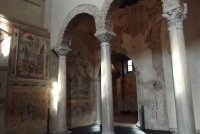
I succeeded in reaching six of the listed locations forming part of this site :
Cividale del Friuli - Longobard temple. Reached by train from Udine
Brescia - St Salvatore/Santa Giulia monastery.
Monte Sant'Angelo - Sanctuary of St Michael, attracted numerous pilgrims. Reached by bus from Foggia and Manfredonia.
Benevento - St Sophia church
Spoleto - Basilica of San Salvatore. Reached by bus 'D' from thestation to the cemetery. The basilica adjoins the cemetery on the uphill side.
Campello sul Clitunno - Longobard temple. A 3km walk from the station past the Clitunno spring.
Keep reading 0 comments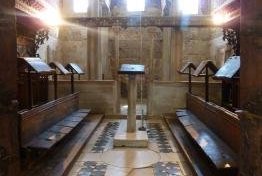
My first taste of this site, which is spread across Italy, was in the delightful town of Cividale del Friuli tucked up in the North East near the Slovene boarder. The town was a rather wonderful clump of cobbled streets, erratic squares and precipitous bridges cut through by the powder blue waters of the river Natisone.
This was the first capital of the Longobards in Italy so seemed like a great place to start with this site. The actual inscribed bits of the town are limited to the cathedral and the area surrounding it. I must admit to not finding the cathedral particularly remarkable, however the real highlight was behind in the Lombard Temple. The temple is in a pleasant ecclesiastical complex, and is pretty tiny, however the delicate, almost brittle looking woodwork and frescos were exceptionally rewarding. The wonderful view from the jasmine scented terrace at the exit was great.
After this I had a trip around the museum which had a fine selection of Roman (the town was founded by Julius Caesar), and Longobard exhibits, including the contents of graves from the nearby necropolis.
I doubt I could design a more pleasant place to while away a sunny Sunday morning, a slow cappuccino overlooking the Duomo was the perfect way to slow down after a wonderful night out in nearby Udine, which is a lovely place to bar hop on a Saturday night.
Hopefully in the future I will visit more of this serial inscription; if they are …
Keep reading 0 comments
I have visited the San Salvatore-Santa Giulia museum complex and Brescia. Although the highlights of the complex are the Winged Victory and the richly decorated Santa Maria in Solario containing the crucifix of the Lombard king Desiderius, I think the museum's most significant contribution is the extent to which it documents the history of Brescia. From prehistory to today, the museum is packed with artifacts, both fascinating and mundane, tracing the development of the city through the ages. Outside of the museum, one can also explore remains of civilizations from the Romans and beyond through open-air excavations. This summer, I will also visit Cividale, Castelsprio, and Monte Sant'Angelo, so I will update when I get the chance.
I suspect that this list will most likely be expanded in later years. Namely, Pavia would probably be added for being the Lombard capital and for a few surviving churches from the era. Also, Monza will probably be added as well for housing the Lombard crown.
Keep reading 0 comments
Being interested in medieval history and all things Italian, I was really looking forward to seeing this site inscribed. Sites from late Antiquity and the early Middle Ages are rather underrepresented on the list, and this seems to fill the gap at least a bit. When I looked at the individual sites, I was slightly surprised to find a site that I had been to a few years ago - the Sanctuary of San Michele in Monte Sant'Angelo, in the southeastern region of Puglia. Dedicated to the Archangel Michel, this is one of Italy's most important shrines and pilgrimage sites. I knew about the connection of this place to the Normans, but I was unaware of any Longobard influence here. Well, there isn't such a big one really, it's just that one Longobard king (Rothari) was buried there. I'm not sure this is enough to include it in a Longobard-themed WHS, but I probably missed his burial chapel when I was there (reason enough to return one day...). The other sites seem to be worth a visit as well, although I'm surprised that Pavia, capital of the Longobards, is not included (it is a separate site still on Italy's T list).
Keep reading 0 comments
